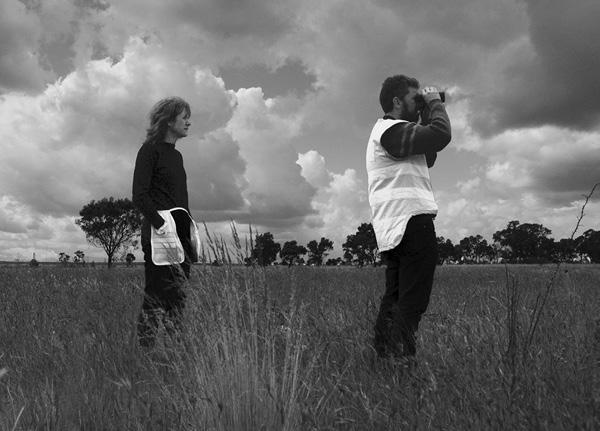
WEARING WEEDS, WORKING THE MERRI
first performed on November 18, 2012
Bababi Marning, Merri Creek, Campbellfield, Australia
performed twice in 2012
REBECCA MAYO
Lisa Lawrence, Brian Bainbridge, Fam Charko, Zoe Phillips, Lesley Harding
Melbourne, Victoria, Australia
rebeccamayo.com
WEARING WEEDS, WORKING THE MERRI
REBECCA MAYO
“Wearing weeds” grew out of the problem of how to articulate the performative nature of ecological restoration. By positioning the art of performance within the locus and temporality of citizen restoration work, I aim to highlight the daily practice and sites of agency present in ecological restoration.
The Merri Creek runs from the Great Dividing Range through the northern suburbs of Melbourne, Australia, until it joins with the Yarra River in the inner city. This significant and much-loved waterway is under constant pressure from development and urban storm water runoff. Simultaneously, it hosts an active and passionate restoration community made up of volunteers and paid workers.
This artwork began with the harvesting of invasive weeds along the creek. Dye extracted from the weeds was used to print and dye fabric, which in turn was used to make garments (collection pockets and safety jackets). By wearing the garments during organized events along the creek, volunteer workers produced impromptu performances that were situated within the context of ecological work.
The weedy garb, a product (or by-product) of the creek, connects the worker to the site via the plant dye. The performer (wearer)/restorer (worker) is aware of the trace of the weeds in the cloth on their body as they move around the site performing their weeding, planting or surveying. The slow, process-laden work of dyeing, printing and making is echoed in the repetitive and never-ending work of restoration.
The impromptu and unstaged nature of these performances, where there is no official audience apart from the participants, reveals the quiet, persistent work of restoration. Evidence of successful restoration work is revealed over years, or even decades. The citizen volunteer is not motivated by instant reward or public esteem; rather, their urgency stems from a desire to act before it is too late, to curb loss and its subsequent grief. It is an act of hope, and the repurposing of weeds into functional garments seeks to articulate this tension between restoration and degradation. The garments, worn by volunteers as pseudo-uniforms, activate the space between worker and creek, human and action, thereby heightening the purpose and intention of the act of restoration.
These performances, without audience, are experienced vicariously through their documentation. The photograph of the performance and the weedy garment worn repeatedly at numerous events bear traces of the creek, its weeds and the activities along its banks.